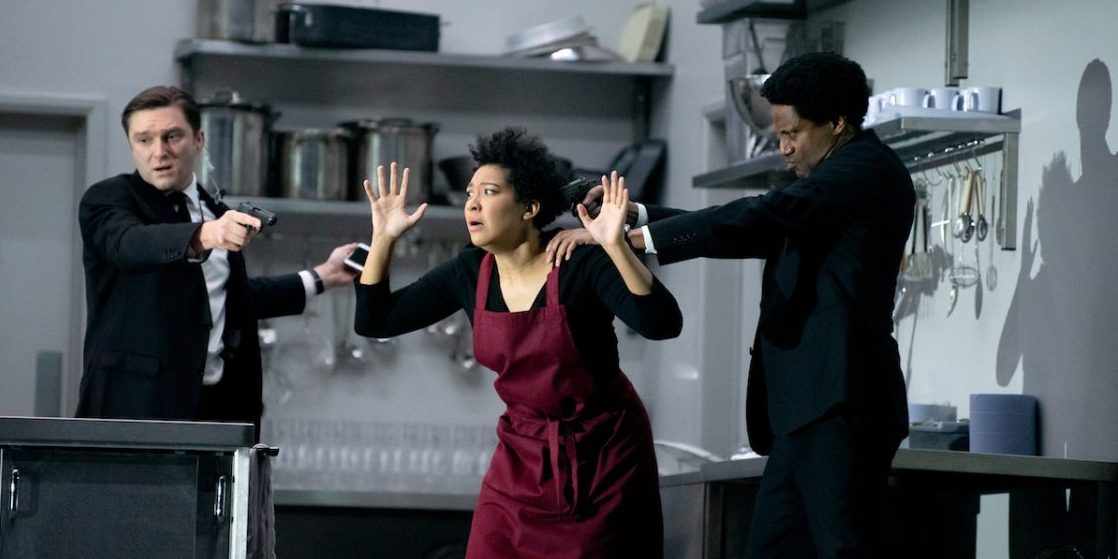‘Theodora’ began life at Covent Garden as an oratorio in 1750 but has not been heard there since. However, it has long been praised as one of Handel’s finest achievements and has attracted benchmark productions, such as the 1996 Glyndebourne representation by Peter Sellars. Perhaps the fact that it is labelled as an ‘oratorio’ has deterred companies, but in fact, there is little in common between this work and such works as ‘Messiah’, and the only reason it was not fully staged was the convention that works on religious themes could not be performed in eighteenth-century theatres.
The plot concerns the persecution of a group of Christians in Antioch in the 4th century CE. Irene and Theodora and their followers refuse to kowtow to the demands of the Roman governor Valens to worship pagan gods. They are joined and aided by one of the governor’s guards, Didymus, and ultimately embrace martyrdom for their beliefs – or not, if this production is to be believed. Director Katie Mitchell has decided that there is too much passivity and acceptance in this stance, particularly on the part of the two much-abused female leads. Instead, the action is reset to a contemporary Embassy where the Christians work below stairs in the kitchens engaged in manufacturing a bomb aimed at their oppressors. Valens and his guards are sharp-suited but sleazy, keeping a brothel with pole-dancers in the palace, and ready to respond with elaborate violence to the slightest opposition. This is a world of glittering surface and thuggery below, where drastic means meet equally drastic remedies.
This approach has mixed results. On the one hand this is a very busy production with lots happening visually, especially when the excellent sliding sets by Chloe Lamford allow you to see action in up to three locations in parallel. When the music is often meditative, reflective, and (because of the ‘da capo’ aria format) necessarily repetitive, you need an injection of narrative momentum and incident. Mitchell provides this in spades and all credit to the singers who must act, fight, dance (and indeed pole-dance) on top of their main task. There is a lot of admirable invention here. However, not all of it is really in sympathy with the general tenor of the original and at points actually flies in the face of it, particularly in the ending. You cannot get away from the fact that this is a piece with religious faith at the heart of it, and a faith that willingly accepts death with the promise of a life to come in place of an unbearable life. This is very different from the relentless activism and resistance on offer here, admirable as that may be in a wholly secular setting. But the latter is not what Handel and his librettist are offering.
That said, the musical and dramatic sides of things are wholly admirable. All the leads are in fine form, and it is a rare pleasure to hear each in the long series of exquisite arias dispatched in tasteful and dramatically satisfying ways. Didonato, in particular, is in peerless form with a refulgent tone and affectingly plangent cadenzas. Orlinski spins some expertly modulated lyrical lines as well as develops feisty combative exchanges with his oppressors. Bullock is less assertive vocally, but that is in part due to the more recessed, reflective writing that Handel gives to the title role. Lyon and Orendt do their best with the main villain roles, where the vocal writing is feisty but the characterisation more two-dimensional. As usual, in late Handel, there are plenty of fiery choruses of defiance and consolation for the Christians presented skilfully by Covent Garden’s house chorus.
Harry Bicket and the house orchestra set a brisk pace in the pit, very necessary in what is a long evening. But there is room for some exquisite solo instrumental work woven in and around the voices especially from the continuo chamber group underpinning the extensive recitatives. This is not a work where bombast is to the fore, and where that occurs it is associated with the Romans lending a negative shade.
This is a hugely stimulating evening into which all the collaborators have injected great creative energy and invention. Not all of it works, and some of its fights against the irreducible grain of the piece. But the production is always engaging and challenging and provides an excellent showcase for some of the most sublime and profound music written in the eighteenth century that is still too rarely heard.

